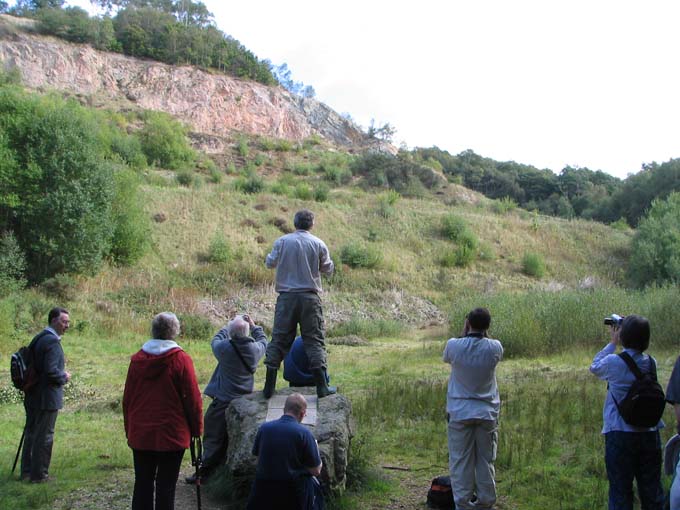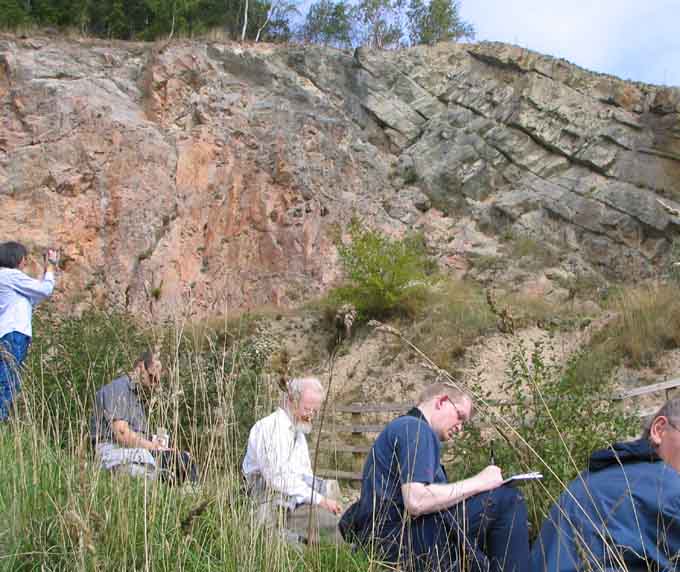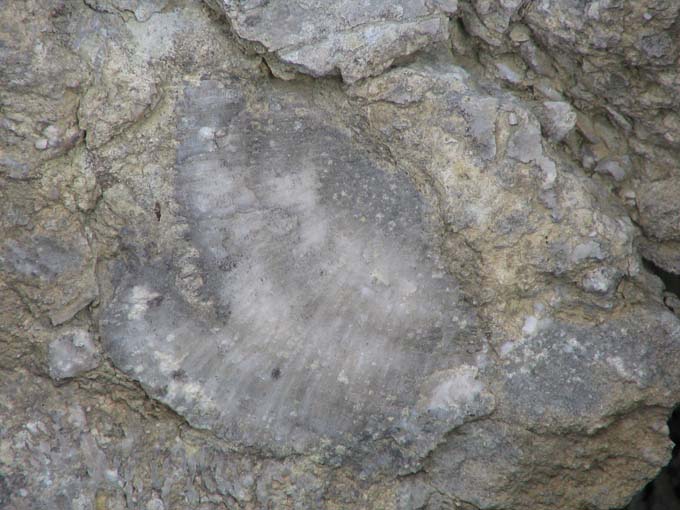
BCS Geology Workshop, 15-17 September 2006
Our workshop this year was based at Cloverley Hall, in Shropshire, with the theme: “Understanding the Palaeozoic”.
David Tyler introduced the workshop by considering “Darwin’s links with Shropshire and North Wales”. Although Darwin had attended some geology courses at Cambridge, it was not until the summer of 1831 that he gained some familiarity with field geology. This was to be crucial preparation for his voyage on HMS Beagle. Basically, Darwin’s mentor was Professor Adam Sedgwick, who was preparing for his own research into the stratigraphy of the lower Palaeozoic rocks in the North Wales area. Sedgwick helped Darwin with field techniques, recognition of different rocks and minerals, and documentation. Useful material for understanding this phase of Darwin’s life has been provided by Michael Roberts (2000). Whilst Darwin gained field expertise in the company of Sedgwick (and indirectly fom Henslow), he absorbed the conceptual framework for interpreting data from Lyell’s Principles of Geology. This conclusion differs from Roberts, who does not distinguish between the gaining of field experience and the development of geological concepts.
"Should we all go home before the coffee break?" was an exploration of some reasons why our efforts are important, why the Lord's character, His concern for His Church and desire for people to be saved are the real issues for us today. We were shown that New Testament references to the Flood emphasise, more than any other characteristic, that it was sudden and unexpected. This has frequently been overlooked by Flood geologists, with the consequence that there have been many speculations about flood models and there is little convergence of thinking. The situation in the 19th Century, with the Scriptural Geologists, was compared with the contemporary scene. The same mistakes are being made, and we run the same risk of being ineffectual. Building on the New Testament witness is the way to break out of the many cul-de-sacs existing today.
David Tyler spoke on Trilobites: “Beetles of the Palaeozoic”. Trilobites have only been found in Palaeozoic strata: from Cambrian to Permian. The number of species is extraordinary. What sense can be made of the data: their stratigraphical distribution, the radiations of species and patterns of extinction? We considered three areas for creation-based research. The first considers trilobites as examples of intelligent design in nature. The second concerns interpreting the numerous trilobite species in terms of Basic Types (and consequently to created kinds). Thirdly, there is a need to understand the stratigraphical context for the trilobite fossil record. We looked at explanations from the perspectives of evolutionary theory, diluvialist thinking that puts the Palaeozoic within the 1-year flood, and diluvialism as being develoed by recolonisers.
Paul Garner gave a presentation on The base of the Coconino Sandstone: evidences of desiccation or tectonics? The Permian Coconino Sandstone (from the Grand Canyon in the US) has some unusual cracks at its base. These have been interpreted as a desiccation feature, but evidence is accumulating that a tectonic explanation is preferable. The characteristics of the cracks were described, noting their relevance to the alternative models of origin. The relevance of this research was discussed in the context of the depositional model for the Coconino as a unit: whether it is better understood as an aeolian deposit or whether it was water-laid.
The next talk asked the question: "What do Ordovician hardgrounds tell us about life, time and therefore, the Flood?" In past workshops, hardgrounds have been a major factor in our thinking about time in the Mesozoic and Cenozoic. The major example has been the Jurassic hardground at Frome. We now ask: what constraints are introduced from the study of Palaeozoic hardgrounds? As a case study, Ordovician rocks exposed in Maysville, Kentucky were considered. Some information about these rocks is found here. The strongest evidence for hardgrounds comes from encrusting bryozoans, enclosing shell fragments, with borings through the bryozoans stimulating response reactions by the affected bryozoans. Cuffey (1997) has made an attempt to quantify the duration of a middle Ordovician limestone in Pennsylvania, His estimate - up to a million years - assumes hardground development within every limesone/shale couplet (the physical evidence for this is weak) and assuming that the storm track (controlling deposition) revisited the same place only once every hundred years or more, an entirely arbitrary and uniformitarian assumption. In an alternative approach, some horizons can be used to make a convincing case for hardgrounds, whereas other cases can be explained by recycling shell debris. Given generous estimates for rapid growth, timescales for these rocks - and therefore much of the middle Ordovician - of the order of 10 years were suggested.
As his second talk, Paul Garner took the subject of “Graptolites in perspective”. Finding a rock with fossilised graptolites means that the finder has been looking in Palaeozoic rocks. But what are graptolites? How are they to be understood? Do they give support to evolutionary theory? The biology of these colonial animals was reviewed, together with a discussion of what can be learned from the rocks in which they are found. Although graptolites have been used in the past as examples of evolutionary development, the modern view is that Darwinistic interpretations are inappropriate. “Most graptolite taxa tend to, well, just appear in any individual section, as more or less distinct entities, the spirit of punctuated equilibrium presumably hovering somewhere nearby. Evolution always […] seems to have happened somewhere else.” (Zalasiewicz, 2006)
An introduction to the local geology and the field excursions was provided by David Tyler. The area around Shropshire is important historically, as Murchison developed the “Silurian System” in this part of the country during the 1830s. Contemporary thinking has moved beyond description to consider the geological processes responsible for the observed sequences of rocks. Focusing on the late Precambrian/Cambrian and the Silurian, the plate tectonic scenario for understanding the field trip locations was reviewed.
Field Excursions
The Wrekin District (Precambrian/Cambrian)
The morning excursion considered:
- Uriconian rocks intruded by two dolerite dykes exposed by the Forest Glen Pavilion Car Park.
- Granophyre intrusion into the Uriconian Volcanics overlain unconformably by the basal Cambrian Wrekin Quartzite. This is the classic exposure at Ercall Quarry and one of the more spectacular unconformities in the UK. The quartzite shows ripple marks. Above the Quartzites are the Comley Sandstones.

The group surveys the Cambrian Unconformity in Ercall Quarry from a distance.
Discussion considered:
1. The extensive igneous/volcanic activity in the Late Precambrian in this area, followed by the relative lack of evidences of igneous activity in Cambrian strata. A variety of lithologies were seen, including clastic deposition with cross bedding. The coarse quartz grains were observed to be rounded. This stimulated some comment, because rounded grains are normally a result of extended transport in water (or air) and yet these particular sediments were immature.
2. The date of ~560 Ma obtained from the Ercall granophyre. This was a significant factor for bringing down the start of the Cambrian from 570 million years (Ma) to 540 Ma and putting a tighter squeeze on the “Cambrian Explosion” timescale.
3. The granophyre under the Cambrian rocks was fresh, not weathered. This suggests the importance of erosive forces in this locality, consistent with the planar unconformity and no differential weathering. (For further discussion on another notable case, see here.
4. The global prevalence of white sandstones (“quartzites”) at the base of the Cambrian. The ripples were non-directional, indicating that this phase of sedimentation was not particularly violent, nor strongly influenced by a nearby beach. We looked for evidences of bioturbation of these rocks but none was noted in the field exposures.

The debriefing discussion below the Cambrian Unconformity.
Wenlock Edge (Upper Silurian limestones).
The afternoon excursion commenced at the Presthope National Trust Car Park. Here we walked to Knowle Quarry. Two quarry faces were inspected, showing the bedded limestone facies, the ballstone facies and a bentonite seam. The locality is documented here. The ballstones are often referred to as “bioherms” or “reefs”, and this is what we sought to examine.
We then moved on to another disused quarry where we could get a closer look at the bedded facies and the ballstone facies. At this location, some fine examples of tabulate corals and stromatolites were recovered by members of the party.

An upside-down coral in bedded limestones: a sign of a death assemblage.
A virtual tour of these rocks is on the Sedgwick Museum web site here.
An example of a ballstone (from Coates Quarry) is here.
An excellent presentation on recognising a death assemblage is here.
Our discussion considered:
1. The lack of framework building organisms in the ballstones, the micritic matrix and the problems of modern analogues.
2. The relationship between the ballstones and the bedded facies, and whether these structures deserved the name “reef”.
3. The bentonites as event horizons.
4. The diversity in the fossil assemblage: brachiopods, corals, crinoids, bryozoans, stromatoporoids, trilobites and the less common nautiloids, bivalves and gastropods.
References:
Cuffey, R.J., 1997. Prasopora-bearing event beds in the Coburn Limestone (Bryozoa;Ordovician; Pennsylvania). In Brett, C.E., and Baird, G.C., eds., Paleontological Events: Stratigraphic, Ecological, and Evolutionary Implications; Columbia Univ. Press, New York, pp. 110-130.
Roberts, M. 2001. Just before the Beagle: Charles Darwin’s geological fieldwork in Wales, summer 1831. Endeavour, 25(1), 33-37.

